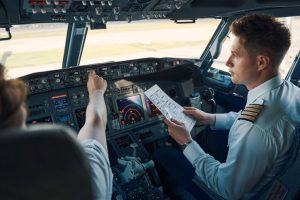Staying Balanced on the Ground and in the Air
A solid understanding of weight and balance is imperative to aircraft performance and remaining safely with the flight envelope.
Knowing the definitions and associated concepts help pilots to ensure they are correctly applied during flight planning.
Important Terms
When looking at aviation flight planning, pilots need to be familiar with many common weight and balance terms, including:
- empty weight
- basic operating weight
- maximum takeoff weight
- maximum landing weight
- fuel load
- zero fuel weight
- useful load
- station
- moment
- center of gravity (CG)
- CG limits
- chord
Here are the basics.
- Basic aircraft empty weight is the weight of the aircraft without passengers, baggage or usable fuel.
- Basic operating weight accounts for all of the fluids necessary for the aircraft to operate including oils, hydraulic fluid, coolant, water, and fuel.
- Maximum takeoff weight is straightforward; it is simply the maximum weight a pilot can plan a takeoff due to aircraft limitations, structural or otherwise.
- Maximum landing weight is the maximum weight at which an aircraft can land and remain within limitations.
- Fuel load is the expendable fuel in the aircraft; however, it does not include any fuel in fuel lines or tank sumps.
- Zero fuel weight refers to the maximum certified aircraft weight prior to useable fuel being added.
- Useful load is the weight of the crew, passengers, baggage, usable fuel, and drainable oil. Generally, this can be found by subtracting the basic empty weight from the maximum allowable gross weight.
- Station is the term used to define a specific location, determined from the reference datum, on the aircraft.
- Arm is the distance in inches from the reference datum line to the center of gravity of an item; the station and arm are usually identical.
- A moment is a force that results in the tendency for an object to pivot around a point. Moments are key because they are used to calculate an aircraft’s center of gravity, the longitudinal and lateral limits.
- One last term worth keeping in mind is mean aerodynamic chord. As we know, the chord is a line between the leading and trailing edge of the wing, measured parallel to the normal airflow over the wing; on a tapered wing the chord varies and the average is the mean aerodynamic chord (MAC); CG is typically defined as a percentage of MAC (% MAC).
All of these terms are relative to pilots because they provide the vocabulary and knowledge necessary to understand and calculate weight and balance.
Calculating Center of Gravity
To determine an aircraft’s CG, find the weight and arms for the aircraft’s entire mass. Then, the pilot needs to multiply the weights by the arms to calculate the individual moments (Weight x Arm = Moment). These moments need to be added together to find a total moment. Finally, the total moment gets divided by the total weight (Total Moment / Total Weight = CG). The solution from this equation is the arm of the CG, so long as this arm falls within the limits dictated by the aircraft manufacturer, the aircraft is considered to be safe for flight.
Understanding these common weight and balance concepts is imperative to aircraft performance and requires consideration to all aircraft and every flight.
RELATED READING
RELATED CTS TRAINING










